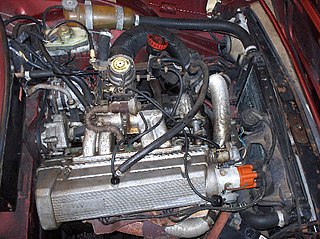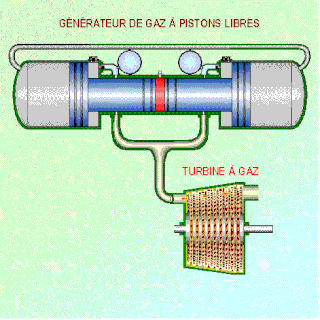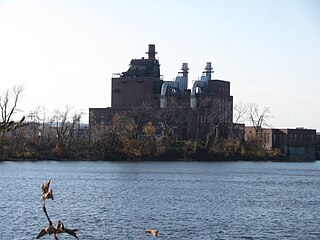Related Research Articles

The diesel engine, named after Rudolf Diesel, is an internal combustion engine in which ignition of the fuel is caused by the elevated temperature of the air in the cylinder due to mechanical compression; thus, the diesel engine is called a compression-ignition engine. This contrasts with engines using spark plug-ignition of the air-fuel mixture, such as a petrol engine or a gas engine.

A two-strokeengine is a type of internal combustion engine that completes a power cycle with two strokes of the piston during one power cycle, this power cycle being completed in one revolution of the crankshaft. A four-stroke engine requires four strokes of the piston to complete a power cycle during two crankshaft revolutions. In a two-stroke engine, the end of the combustion stroke and the beginning of the compression stroke happen simultaneously, with the intake and exhaust functions occurring at the same time.

In internal combustion engines, exhaust gas recirculation (EGR) is a nitrogen oxide (NOx) emissions reduction technique used in petrol/gasoline, diesel engines and some hydrogen engines. EGR works by recirculating a portion of an engine's exhaust gas back to the engine cylinders. The exhaust gas displaces atmospheric air and reduces O2 in the combustion chamber. Reducing the amount of oxygen reduces the amount of fuel that can burn in the cylinder thereby reducing peak in-cylinder temperatures. The actual amount of recirculated exhaust gas varies with the engine operating parameters.
An oxygen sensor (or lambda sensor, where lambda refers to air–fuel equivalence ratio, usually denoted by λ) or probe or sond, is an electronic device that measures the proportion of oxygen (O2) in the gas or liquid being analysed.
Dieseling or engine run-on is a condition that can occur in spark-plug-ignited, gasoline-powered internal combustion engines, whereby the engine keeps running for a short period after being turned off, drawing fuel through the carburetor, into the engine and igniting it without a spark.
Homogeneous Charge Compression Ignition (HCCI) is a form of internal combustion in which well-mixed fuel and oxidizer are compressed to the point of auto-ignition. As in other forms of combustion, this exothermic reaction releases energy that can be transformed in an engine into work and heat.

In a piston engine, the crankcase is the housing that surrounds the crankshaft. In most modern engines, the crankcase is integrated into the engine block.

A diesel particulate filter (DPF) is a device designed to remove diesel particulate matter or soot from the exhaust gas of a diesel engine.

A diesel generator (DG) (also known as a diesel Genset) is the combination of a diesel engine with an electric generator (often an alternator) to generate electrical energy. This is a specific case of engine generator. A diesel compression-ignition engine is usually designed to run on diesel fuel, but some types are adapted for other liquid fuels or natural gas.

The hot-bulb engine is a type of internal combustion engine in which fuel ignites by coming in contact with a red-hot metal surface inside a bulb, followed by the introduction of air (oxygen) compressed into the hot-bulb chamber by the rising piston. There is some ignition when the fuel is introduced, but it quickly uses up the available oxygen in the bulb. Vigorous ignition takes place only when sufficient oxygen is supplied to the hot-bulb chamber on the compression stroke of the engine.

In a spark ignition internal combustion engine, ignition timing is the timing, relative to the current piston position and crankshaft angle, of the release of a spark in the combustion chamber near the end of the compression stroke.
Engine efficiency of thermal engines is the relationship between the total energy contained in the fuel, and the amount of energy used to perform useful work. There are two classifications of thermal engines-
- Internal combustion and
- External combustion engines.

A glow plug engine, or glow engine, is a type of small internal combustion engine typically used in model aircraft, model cars and similar applications. The ignition is accomplished by a combination of heating from compression, heating from a glow plug and the catalytic effect of the platinum within the glow plug on the methanol within the fuel.

A free-piston engine is a linear, 'crankless' internal combustion engine, in which the piston motion is not controlled by a crankshaft but determined by the interaction of forces from the combustion chamber gases, a rebound device and a load device.
Crankcase dilution is a phenomenon of internal combustion engines in which unburned diesel or gasoline accumulates in the crankcase. Excessively rich fuel mixture or incomplete combustion allows a certain amount of fuel to pass down between the pistons and cylinder walls and dilute the engine oil. It is more common in situations where fuel is injected at a very high pressure, such as in a direct-injected diesel engine.
Internal combustion engines come in a wide variety of types, but have certain family resemblances, and thus share many common types of components.

The West Springfield Generating Station, also known by its corporate name EP Energy Massachusetts, LLC, is a fossil-fuel-fired power plant located in West Springfield, Massachusetts. The station is a "peaking" facility, meaning that it primarily operates during peak electrical demand. The facility consists of two 49-megawatt (MW) combustion turbine generators fueled by natural gas or ultra low-sulphur diesel fuel, one 18 MW jet turbine that is fueled by kerosene, and one 107 MW simple-cycle steam boiler unit burning no. 6 fuel oil, ULSD or natural gas. The station also has a small auxiliary boiler for process and building heat and an emergency back-up generator. The station's management also operates several small remote power generators including two other jet turbines identical to West Springfield 10 which are the Doreen Street unit in Pittsfield, Massachusetts, and Woodland Road unit in Lee, Massachusetts as well as five run-of-river hydroelectric power stations located on the Chicopee and Deerfield Rivers.

Wärtsilä is the second largest diesel engine company in the world. Wärtsilä released the Vasa engine series in 1977 and remained in production until 2010. These popular medium speed diesels were produced in Vasa, Finland; hence their name, Vasa. The lead designer of the first engine was Wilmer Wahlstedt. The series comprises three models, the Vasa 22, 32, and 46, with the number denoting the bore size of the engine. Vasa 32 engines are the most popular of the series and can still be found throughout the marine and power generation industries.
Four-stroking is a condition of two-stroke engines where combustion occurs every four strokes or more, rather than every two. Though normal in some instances at idle, extremely high engine speeds, and when letting off the throttle, such firing is uneven, noisy and may, in cases of malfunction, damage the engine if allowed to continue unabated.

An internal combustion engine is a heat engine in which the combustion of a fuel occurs with an oxidizer in a combustion chamber that is an integral part of the working fluid flow circuit. In an internal combustion engine, the expansion of the high-temperature and high-pressure gases produced by combustion applies direct force to some component of the engine. The force is typically applied to pistons, turbine blades, a rotor, or a nozzle. This force moves the component over a distance, transforming chemical energy into kinetic energy which is used to propel, move or power whatever the engine is attached to.
References
- ↑ Burl Donaldson, Patent Assigned to New Mexico State University Technology, Feb 1, 2005, Patent US6848419
In order to avoid failures from either type of wetstacking, the conventional advice is that the engine should never be operated for extended periods of time at less than half-load. In order to assure that the engine operates at a load of at least 50%, artificial loads are sometimes applied... Wetstacking also occurs when solid carbon or nonvolatile liquids accumulate along the cylinder wall or in the piston ring grooves and inhibit expansion and sealing of the ring against the cylinder wall. The cylinder can become glazed which further contributes to poor charge air compression heating and poor combustion of fuel. The performance of the engine continues to deteriorate until charge air compression heating is no longer sufficient for the engine to operate.
- ↑ Tawanda Hove, Dept. of Mechanical Engineering, University of Zimbabwe, Zimbabwe, Henerica Tazvinga, Dept. of Electrical, Electronic and Computer Engineering, University of Pretoria, South Africa. Journal of Energy in Southern Africa • Vol 23 No 4 • November 2012
It is already well known that when the diesel engine is operated for long periods at a partial load, a condition known as ‘wet-stacking’ occurs (Donaldson, 2005). This is mainly attributed to incomplete combustion of fuel when the engine runs at low operating temperature. This results in reduced fuel efficiency and, simultaneously, shortening of engine operating life, and the time interval between routine maintenance calls.
- ↑ Volt Master America, Engine Driven Generator Set Owner’s Manual, publication number 2593-CON, Revision 05/2009
Operating the engine without an electrical load for prolonged periods of time (one hour or more) will eventually cause damage to the diesel engine (sometimes called wet stacking which is NOT covered by the engine manufacturer’s warranty) or damage to the rings, fuel oil entering the lubricating oil and excessive vibration. Breaking in the diesel engine can require 5 to 10 hours of operation. It is extremely important to have electrical loads of at least 25% to 50% of the rated capacity of the generator’s nameplate rating to have the valves properly seat.
- ↑ "Diesel Generator Wet Stacking - What Is It & How to Prevent It?" . Retrieved 2021-01-08.
- ↑ Gus Wright, Fundamentals of Medium/Heavy Duty Diesel Engines, Jones & Bartlett Publishers, 2015 ISBN 128406705X page 234
- ↑ "Diesel Generator Wet Stacking - What Is It & How to Prevent It?" . Retrieved 2021-01-08.